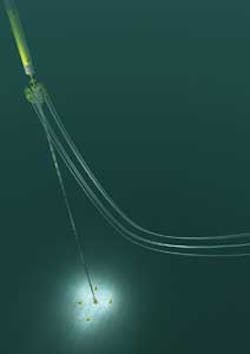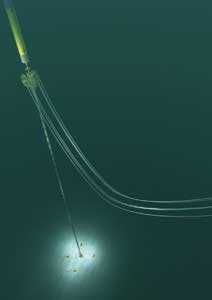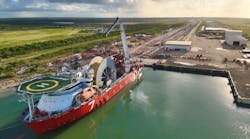Jeremy Beckman
Editor, Europe
In June, Total started production fromCLOV, its fourth large-scale deepwater development in block 17 offshore Angola. The basic concept follows the previous three models, with produced oil and gas routed via a network of subsea wells and interlinked flowlines to a spread-moored FPSO. CLOV is the second project after Girassol to connect the risers to the FPSO via hybrid riser towers (HRTs) designed and supplied by Subsea 7, the sole specialist in this technology.
Acergy (later merged with Subsea 7) pioneered the HRT concept in the late 1990s forGirassol, Angola's first deepwater field project, where three HRTs were successfully connected to the FPSO and remain in service today. The HRT is a free-standing tower that bundles together risers of varying diameters and functions to form a pliant structure. At the tower's base is an interface structure that connects the risers to the flowline spools. The bottom of the tower is anchored by a flexible joint to a locking device, securing the entire structure to the seafloor. The top of the riser tower bundle is connected to a buoyancy tank that maintains tension in the structure, and the top ends of the risers are linked via flexible jumpers to the FPSO.
Each HRT is designed for optimum flow assurance, taking into account reservoir pressure, temperature, and heat transfer characteristics. Other advantages, according to Subsea 7, include a simplified field layout, with no interference between the various risers, and easier offshore installation. Traditional deepwater flexible and rigid steel catenary risers (SCRs) both require heavy construction vessels to support the weight of the pipe during installation.
These were some of the issues that persuaded Total and its partners to opt for a new concept for Girassol. Another was the fact that the towers would be assembled locally at the purpose-built Sonamet fabrication base in Lobito. In recent years local content has become increasingly important to Angola's government, and was a critical factor in Subsea 7 winning the bid competition for CLOV. Outside block 17, the company has supplied a single HRT for BP's Greater Plutonio FPSO in block 18, and the concept was under consideration for Total'sultra-deepwater Kaombo project in block 32.
Subsea configurations
CLOV gathers production from the Cravo, Lirio, Orquidea, and Violeta fields, with 34 subsea wells and eight seabed manifolds linked by 180 km (112 mi) of pipelines to an FPSO moored 140 km (87 mi) offshore Luanda in 1,400 m (4,593 ft) of water. DSME built the 305-m (1,000-ft) long, 61-m (200-ft) wide vessel which weighs 110,000 metric tons (121,254 tons), with oil production capacity of 160,000 b/d.
Subsea 7 installed most of the subsea facilities and the pipeline network, comprising 40 km (25 mi) of pipe-in-pipe (PIP) production lines, 60 km (37 mi) of water injection (WI) lines, and 32 km (19.9 mi) of gas export lines. Produced gas is exported to the LNG liquefaction plant onshore Angola. Another feature of the development is the use of a subsea multi-phase pumping system to allow production of light and heavier crudes from Oligocene and more viscous Miocene reservoirs.
Both the CLOV HRTs are connected to the FPSO via flexible jumpers, 356 m (1,168 ft) long in the case of the production jumpers, 327 m (1,073 ft) for the WI jumpers, and between 396 m and 416 m (1,299-1,365 ft) for the gas-lift jumpers. The connection point on the riser tower top structure is 130 m (426 ft) below the sea surface, and the horizontal distance between the two towers is 70 m (229 ft).
Approximate weights in air of the three main components of each riser tower are:
- Buoyancy tank: 220 metric tons (242 tons) of steel plus 110 metric tons (121 tons) of foam
- Riser tower itself (the top structure, bundle section, and bottom structure): 2,000 metric tons (2,204 tons) of steel plus 900 metric tons (992 tons) of foam
- Foundation: 590 metric tons (650 tons) of steel including ballast.
Both riser towers have the same general cross-section. The main differences lie in the diameter of the risers and in the fact that the inner pipe of the production riser in the Cravo/Lirio (CL) riser tower includes a layer of corrosion-resistant alloy on its internal wall.
Displaying 1/3 Page 1,2, 3Next>
View Article as Single page






